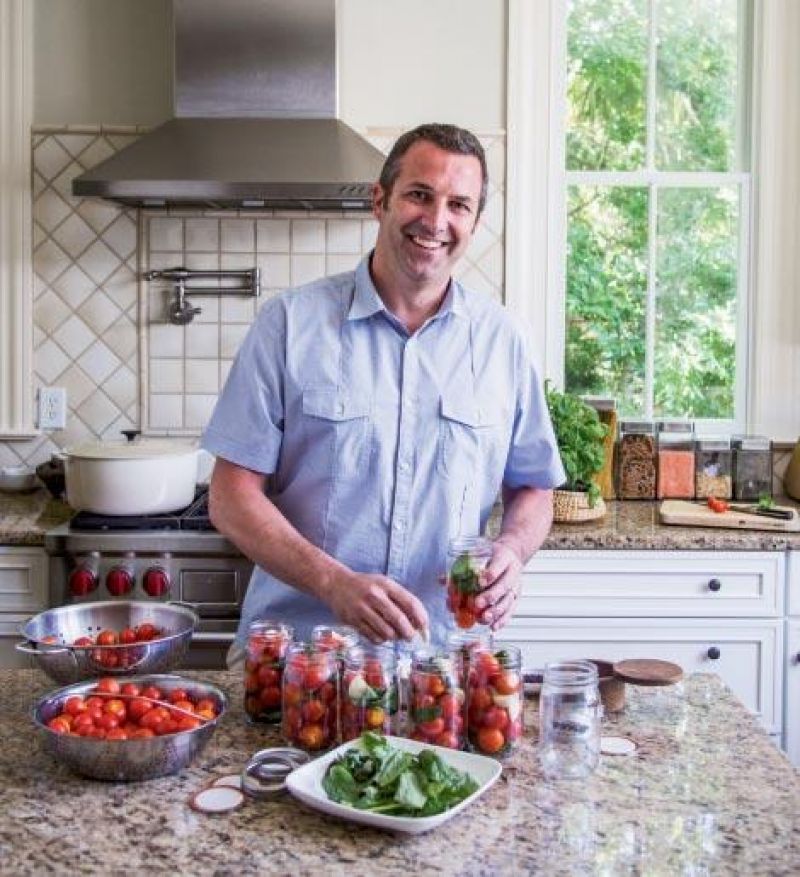
While summer is in full bloom and mountains of verdant produce stock the markets, most chefs are busy updating their menus. The delicate flavors of spring have turned to more robust fruits and vegetables—tomatoes, beans, and peaches—and local cooks take full advantage. Chef Kevin Johnson is among them, but the self-professed “pickle man” is also contemplating other, more preservation-minded affairs—how this perfect produce might be saved for another day.
A walk into his Cannon Street restaurant, The Grocery, reveals that passion literally embedded into the walls. Rows of jars line the nook above the open kitchen like edible trophies, filled with the best products of the seasons, slowly transformed through the alchemy of fermentation into memorable highlights that he describes as “acid, spice, and crunch.” They will inform his cuisine well into the chill of winter and back again.
Say “pickle,” and most people think of cucumbers. But Johnson preserves a variety of produce, expanding flavor profiles outside of their typical seasons. “Pickling allows us to add a brightness that might not be available in the winter, or the depth and structure of something from winter in the middle of summer,” he says.
And while pickling may have taken a turn towards a mass-manufactured commodity in the last century, chefs like Kevin Johnson have a much more inclusive view of its potential. “At The Grocery, we never really start conceptualizing a dish by wondering how we can highlight a particular pickle,” he says. “More often, as the dish evolves, we are compelled to reach into our arsenal to elevate the dish to a different level.”
So the jars pile up on The Grocery’s shelves like a delicious tapestry, and the kitchen staff works overtime preparing the feast. Some produce goes in whole, like dilly beans (green beans spiked with dill) or the freshly picked carrots dunked in brine full of cumin, coriander, and fennel. There are sweet ones and sour ones and fruits that get jarred, awaiting roast pork at Christmastime. Some jars become piquant mixtures, relishes that will back oysters and crab cakes further down the line. Beets in winter bring depth to a summertime charcuterie plate, Brussels sprouts become “Brussels krauts,” and even drinks get a bit of a sour lift. “I love the versatility of green tomatoes,” says Johnson. “They add a nice punch puréed into a salsa verde, and their juice is the backbone to our version of a dirty martini and the savory acidic punch to our charred Bloody Mary.”
Regardless of the ingredient or even myriad herbs or spices that might accompany a preparation, what started historically as a way to safely store vegetables became a taste of cultural significance. In the South, that means okra, tomatoes, and slivers of pickled peppers on a salty, paper-thin slice of cured ham. Your grandma did it. The Grocery excels at it. Using these tips and tricks from chef Johnson, perhaps you can put up a pickle or two.
Tips on sterilizing and processing jars and lids:
Sterilize quart- or pint-size Mason jars by boiling in water for 10 minutes. Allow to cool and dry on a clean cloth. Before filling, wipe the rims of the jars with a clean, dampened cloth.
Pour boiling liquid into jars with produce inside. Top with flat lids then close tightly with rings, but do not over-tighten. Arrange the filled jars in a large pot of water. The water needs to be at least one inch above the jars. Bring to a full boil. Cover and continue boiling—process pints for 10 minutes and quarts for 15 minutes.
Carefully remove jars to a rack or place on table covered with a towel to cool. After jars have cooled slightly (about 10 minutes), invert jars and leave for at least 12 hours. Check lids to ensure all jars have sealed properly.
If proper seal was not achieved, place in refrigerator and use within about two weeks. If properly sealed, store in a cool dark place for one week until flavors have set and are ready to serve. Chef Johnson suggests using the contents within the year. Once a jar is opened, store in refrigerator and use within about two weeks.